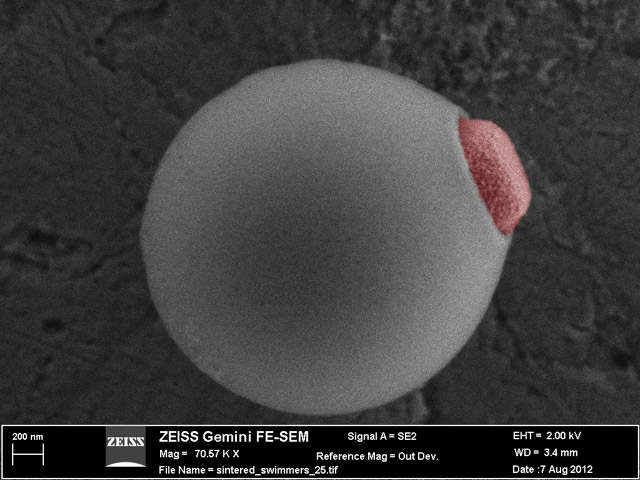Against the Stream
Inanimate beads behave in lifelike ways
Published Date
By:
- Susan Brown
Share This:
Article Content
Scientists have created microbe-sized beads that can utilize energy in the environment to self-propel upstream by purely physical means.
Life is hard to define, but metabolism, mobility and replication are three commonly agreed elements. The beads are not alive, but they meet two of these three requirements.
"Living systems change their behavior according to their environment," said Jérémie Palacci, a professor of physics who joined the University of California, San Diego this year. "So the question was, can we design a particle that can sense its environment with no neural system or biological parts. This is a basic feature of living systems, and the idea was to implement that in a synthetic one."

Electron micrograph of polymer bead with protruding hematite colored red. Photo by Stefano Sacanna
Palacci and colleagues wrapped pale polymer around tiny cubes of hematite, a dark mineral of iron and oxygen that protrudes from the spherical beads as a reddish dot. Left alone in a fluid the beads drift with currents, like sticks in a river.
Under blue light the hematite conducts electricity and when bathed in hydrogen peroxide will catalyze a chemical reaction to split oxygen from hydrogen. This sets up chemical gradients, and osmotic flows. The polymer beads surf forward on those flows in the direction of their hematite protrusions.
In a still bath the beads follow wavering trajectories as the thermal motion of water molecules buffets them from all sides. This pattern of motion, called a persistent random walk, is analogous to the run-and-tumble motion of bacteria, spermatozoa and algae.
If a pipette streams a flow of the hydrogen peroxide fuel into the bath, the beads surf upstream until their forward momentum is equally countered by the flow from the pipette. The particles encircled the tip of the pipette at a distance where their propulsion was cancelled out by the velocity of the flow, Palacci and colleagues report in the journal Science Advances on May 1.
A simple physical model called an overdamped Brownian pendulum describes the pattern and predicts the stagnation point where the beads accumulate.
"What is really cool is that the mechanism we used to get the particles to go upstream actually exists in nature and is used by some parasites to go against flushing flows to colonize bladders,” Palacci said.
It’s an important step toward the realization of biomimetic microsystems with the ability to sense and respond to environmental changes.
Migration along a gradient, called a taxis, is found all over nature. The daily vertical migration of marine plankton toward sunlight, is one example, and it’s the way many microbes find food.
"If you can design particles that can feel their environment and you went one step further into 'smart' particles that could direct themselves towards specific organs, you could think of particles that swim against the blood stream to fix clogged arteries,” Palacci says, adding that such an application is “clearly further down the road."
Co-authors include Stefano Sacanna, Jérémie Barral, Alexander Grosberg, David Pine and Paul Chaikin of New York University, Anaïs Abramian of École Normale Supérieure de Lyon, and Kasey Hanson of Georgia Institute of Technology.
The National Science Foundation's Materials Research Science and Engineering Centers program, U.S. Army Research Office, NASA and Moore Foundation funded this research.
Share This:
Stay in the Know
Keep up with all the latest from UC San Diego. Subscribe to the newsletter today.



